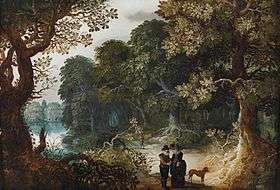Abraham Govaerts

Abraham Govaerts (name variations: Goevaerts, Gouvaert, Goyvaert, Goyvaerts, Godvarte, Goijvaerts) (1589 – 9 September 1626) was a Flemish painter who specialized in small cabinet-sized forest landscapes in the manner of Jan Brueghel the Elder and Gillis van Coninxloo.[1]
Life

He was born in Antwerp where his father was an art dealer. There is no information on his training. In view of the influence on his early oeuvre of Jan Brueghel the Elder, some believe he may have apprenticed in the latter’s workshop but there is no evidence for this.[2] He became a master in Antwerp's Guild of Saint Luke in 1607–1608.
He married Isabella Gielis (died a few days after Govaerts on 13 September 1626), with whom he had two daughters named Isabella en Suzanna. He was active throughout his career in Antwerp. He became deacon of the local Guild of Saint Luke in 1623.[3]
He trained several artists including Alexander Keirincx, Nicolaes Aertsens and Gysbrecht van der Berch.[3][4]
Work
Govaerts was known for his landscape paintings, usually wooded landscapes with a diminutive history, mythological or biblical subject or a hunting scene. His landscapes initially followed the Mannerist style of the three-colour world landscape in which the figures are bracketed by repoussoir trees.[1] His palette at the time exaggerated the brown foreground and the blue tones in the foliage.[4] An example is the composition Diana and Actaeon (Pushkin Museum, Moscow).

Another major influence was the landscape painter Gillis van Coninxloo.[2] A painting entitled Landscape with River Vale and Falcon Hunt (Museum Mayer van den Bergh, Antwerp) is inspired by the work of Joos de Momper.[4]
From 1620 onwards the Mannerist aspect of his palette was replaced by pure and brilliant colours applied in light stippling. He juxtaposed various colours to achieve gradual shading and gentle transitions. This style was more reminiscent of the work of Jan Breughel the Elder. He strived for a dynamic effect in his work by placing dramatic and contorted tree trunks in the foreground and using stark light–dark effects.[4]
As was common at the time, Govaerts often collaborated with other artists who were specialists in specific genres. Govaerts would take care of the landscape while these specialists painted the figures, animals or still life elements. He collaborated often with members of the Francken family such as Frans Francken the Younger and Ambrosius Francken I.[1] An example of such a collaboration is the composition An elegant couple strolling through the forest where Govaerts had the assistance of Sebastiaen Vrancx who painted the figures and dog in the landscape.[2] A landscape composition painted in collaboration with Frans Francken the Younger (Château de Compiègne) showing an open view of a river is uncharacteristic for his oeuvre.
References
- 1 2 3 Hans Vlieghe (1998). Flemish Art and Architecture, 1585-1700. Pelican History of Art. New Haven: Yale University Press, pp. 180–181. ISBN 0-300-07038-1
- 1 2 3 Abraham Govaerts and Sebastiaen Vrancx, An elegant couple strolling through the forest at Gallerie Lowet de Wotrenge
- 1 2 Abraham Govaerts at the Netherlands Institute for Art History (Dutch)
- 1 2 3 4 Hans Devisscher. "Govaerts, Abraham", Grove Art Online. Oxford University Press, [accessed 31 October 2016].
External links
 Media related to Abraham Govaerts at Wikimedia Commons
Media related to Abraham Govaerts at Wikimedia Commons